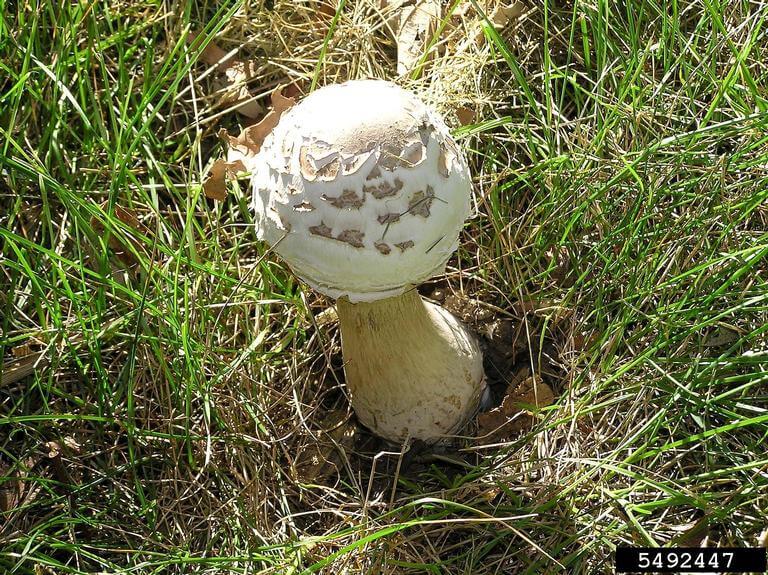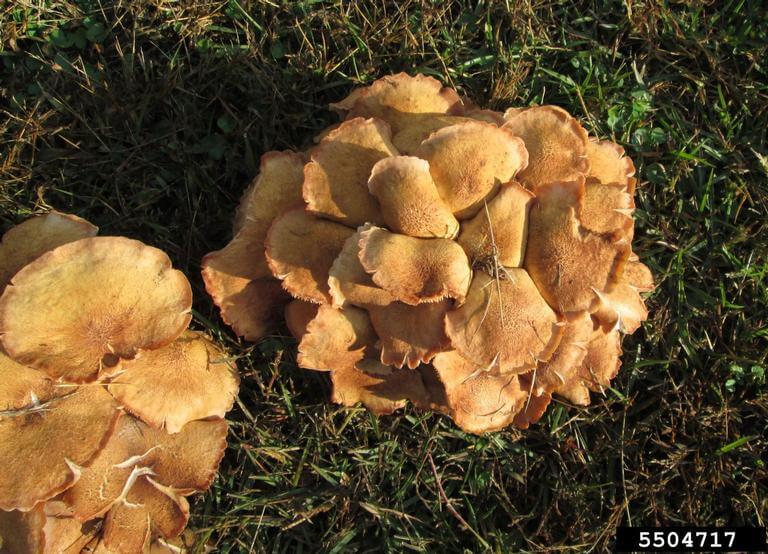
Mushrooms in your lawn and garden are almost always harmless and are even helpful. Photo: Curtis E. Young, The Ohio State University, Bugwood.org.
The heavy rains we have had lately may have led to mushrooms sprouting in your lawn or garden beds. Clients often ask us if they should worry about these mushrooms.
Should you be concerned?
In most cases, having mushrooms in your lawn is a good sign. It means that it is healthy, with fertile soil.
The mushrooms in your lawn are almost always completely harmless. And they provide concrete benefits to your yard and plants. They may decompose organic matter. This releases nutrients and makes them available for plant growth. Or they may help plants absorb water and nutrients.
If you have children or pets, it’s best to err on the side of caution and remove the mushrooms. “Pets have been known to eat mushrooms in yards and while on walks,” said the North American Mycological Association. “While 99% of mushrooms have little or no toxicity, the 1% that are highly toxic can cause life-threatening problems in pets. Take extra care to keep pets away from areas where mushrooms might be growing.”
Can you get rid of lawn mushrooms?
As noted in AmericanMushrooms.com, “The simple answer is, you can’t get rid of lawn mushrooms without getting rid of the lawn. . . . Fungi are a vital part of every plant-based ecosystem, whether natural or manmade. Lawn grass would not be very healthy if there weren’t mycorrhizal fungi on its roots.”
Fairy ring fungi

Fairy ring. Clemson University – USDA Cooperative Extension Slide Series, Bugwood.org.
Fairy ring is common in lawns. The mushrooms are visible in spring and summer. Several different types of fungi may cause fairy rings. Typically, fairy ring is not detrimental to lawn health.
The only control method we recommend is to remove the mushrooms when they appear. This prevents the fungus from spreading. You can collect and compost them, knock them down with a rake or hoe, or mow them over with your lawnmower.
You can mask the symptoms of fairy ring by using a nitrogen fertilizer to green up the lawn. We also recommend watering deeply and infrequently to help the lawn develop deep roots.
Harmful mushrooms

Not all mushrooms are benign. Some, such as armillaria root rot, grow from harmful fungi. Photo: David Stephens, Bugwood.org.
Armillaria is a root rot that has honey colored mushrooms. This fungus is naturally occurring in the Northwest.
Armillaria root disease is the most common forest root disease in Oregon and Washington. In western Washington, it is primarily found in trees that have been stressed.
An infected tree will commonly show a gradual decline. For example, it may develop small, yellowish leaves. You may see reduced growth and dieback of branches. Trees that are chronically infected may wilt suddenly during periods of stress, such as drought.
It is easy to identify armillaria by looking for:
- Honey-colored mushrooms found at the base of the plant (see photo)
- Black shoestring-like structures (called rhizomorphs) found under the bark, around roots or in the soil
- White fungal mats under the bark
Mushrooms of armillaria may develop annually in the fall during wet periods. They usually appear in groups. You may find up to several hundred on or near decaying wood, stump or roots.
Spores from these mushrooms can infect recently wounded plants. However, they apparently do not play an important role in the spread of the disease.
Note: Many other fungi also produce mushrooms on or near decaying wood.
How to prevent armillaria root rot
- Keep your trees and shrubs healthy. Contact us if you would like to know more about our natural tree and shrub care services.
- Water thoroughly during drought periods.
- Provide good drainage.
- Avoid injuring trees.
- Avoid damaging or stressing the roots.
Find out more
If you are interested in knowing more about mushrooms, there are a number of useful sources.
Lawn mushrooms
- Mushrooms and other nuisance fungi, University of California IPM Program
- Fairy ring, Missouri Botanical Garden
- Photos and brief descriptions of about 40 common lawn and garden mushrooms, AmericanMushrooms.com
Armillaria
- Armillaria Root Disease of Conifers, US Forest Service
- Armillaria root rot, University of Minnesota Extension
- Armillaria Root and Crown Rot (Oak Root Fungus), University of California IPM Program
- Armillaria Root Rot of Trees and Shrubs, University of Illinois Crop Extension
Mushroom field guides
- For the amateur mycologist: Mushrooms Demystified by David Arora
- For local mushrooms: Mushrooms of the Pacific Northwest by Joe Ammirati and Steve Trudell
- List and photos of edible mushrooms, Northern Bushcraft
Ed. note: This is primarily a reprint of a blog post from October 2019.

I just read “Don’t worry about lawn mushrooms”and need to comment that my dog became extremely ill after eating a mushroom in the lawn. Thankfully she survived, but that experience was very scary and distressing. I appreciate that you had a comment about erring on the side of caution if children or pets have access to the lawn, but that was at the end of the article. I suggest strengthening the warning and putting it at the beginning of the article, due to the extreme harm the “wrong” mushroom can cause. Thank you.
Thank you for your comment. We were really sorry to read about your dog and are happy she survived. I added a note to the blog post about mushroom poisoning in dogs and cats from the North American Mycological Association. Take a look here: https://inharmony.com/dont-worry-about-lawn-mushrooms/